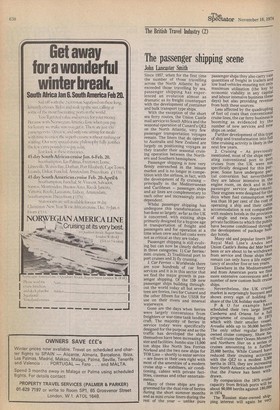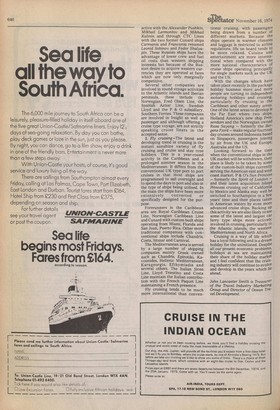The passenger shipping scene
John Lancaster Smith
Since 1957, when for the first time the number of those travelling across the North Atlantic by air exceeded those travelling by sea, passenger shipping has experienced an evolution almost as dramatic as its freight counterpart with the development of container and bulk transport type ships. With the exception of the short sea ferry routes, the Union Castle mail service to South Africa and the seasonal operation of Cunard's QE2 on the North Atlantic, very few passenger transportation voyages remain. The liners that do operate to Australia and New Zealand are largely on positioning voyages as they transfer their seasonal cruising operation between the Northern and Southern hemisphere. Passenger shipping is now very firmly entrenched in the leisure market and is no longer in competition with the airlines, in fact, with the development of fly cruising – principally in the Mediterranean and Caribbean – passenger. ships and air lines are complementary to each other and increasingly interdependent.
Whilst passenger shipping has undergone this transformation it has done so largely, as far as the UK is concerned, with existing ships primarily designed for a bygone age in transportation of freight and passengers and for operation at a time when crew and fuel costs were not as critical as they are today. Passenger shipping is still evolving but can now be clearly defined in three categories: 1) Car ferries/ mini cruises; 2) Traditional port to port cruises and 3) fly cruising. 1. Car Ferries – Worldwide there are now hundreds of car ferry services and it is in this sector that we find the major growth in passenger shipping. Of the 159 new passenger ships building throughout the world today all but seventeen are ferries, two for Cunard and the other fifteen for the USSR for use on their rivers and internal waterways.
Gone are the days when ferries were largely conversions from freighters or war-time tank landing craft. The majority of ferries in service today were specifically designed for the purpose and as the traffic has developed the ships themselves have been increasing in size and facilities. Jumbo size 13,000 ton ships like North Sea Ferries Norland and the two new ships for TOR Line – shortly to enter service – are liners in their own right with most of the amenities of a modern cruise ship – stabilisers, air conditioning, cabins with private facilities, cinemas and other entertainments.
Many of these ships are programmed for the dual role of ferries during the short summer months and as mini cruise liners during the rest of the year – unlike pure passenger ships they also carry vast quantities of freight in trailers and low load vehicles ensuring not only maximum utilisation (the key to economic viability in any capital and labour intensive business these days) but also providing revenue from both these sources.
Less affected by the quadrupling of fuel oil costs than conventional cruise lines, the car ferry business is booming as evidenced by the number of new services and new ships on order.
Further development of this tyPe of ship and transformation into full time cruising activity is likely in the next few years.
2. Cruising – As previously mentioned, most of the ships operating conventional port to port: cruises from the UK were not specifically designed for this Purpose. Some have undergone partial conversion but nevertheless they are labour intensive in the engine room, on deck and in the passenger service department. Their engines were designed for the days when fuel consumption was less than 10 per cent of the cost of operating a ship and their cabin accommodation is not comparable with modern hotels in the provision of single and twin rooms with private facilities to which the public have become conditioned through the development of package holiday hotels. • Many old and popular liners lilt!, Royal Mail Line's Andes anu Union Castle's Reina del Mar have been or are about to be withdrawn from service and those ships that remain can only have a life exPectaricy of another five or ten years. Elsewhere in the Mediterranean and from American ports we find more extensive conversions and a number of new custom built cruise ships.
Nevertheless, the UK cruise, market is surprisingly buoyant 00 shows every sign of holding i" share of the UK holiday market.
P & 0 for example have scheduled their two large liners, Canberra and Oriana for a f0„11 programme of cruising in 19 which with their smaller vessel, Arcadia adds up to 50,000 berths. The only other regular British owned cruise company, Shaw Sa. vill will cruise their Ocean Monarchf and Northern Star on a series 0 cruises amounting to a further 25,000 berths. While Cunard have reduced their cruising activities with the QE2 to a modest 3,5° berths in 1975, they are increasing their North Atlantic schedules noW that the France has been with drawn.
By comparision the 1975 cruise capacity from British ports will about 90,000 berths against 180,0ev in 1974. The Itussian state-owned shiP" ping interest will again be verY
active with the Alexander Pushkin, Mikhail Lermontov and Mikhail Kalinin and through CTC Lines with the two former Cunard ships Carrnania and Franconia renamed Leonid Sobinov and Fedor Shalyapin. These Russian ships have the advantage of lower crew and fuel oil costs than western shipping interests but because of the Russian desire to acquire western currencies they are operated at fares which are now only marginally competitive.
Several other companies are involved in round voyage activities to the Atlantic islands and Iberian peninsula, these include the Norwegian, Fred Olsen Line, the Spanish Aznar Line, Swedish Lloyd and the P & 0 subsidiary, Southern Ferries. These companies are involved in freight as well as passenger and although offering a cruise type voyage, are not strictly speaking cruise liners in the accepted sense.
3. Fly cruising—The latest and developing trend in cruising is the instant sunshine variety of fly cruising and cruise and stay type holidays. This is a year-round activity in the Caribbean and a prolonged summer season in the Mediterranean. It differs from the conventional UK type port to port cruises in that most ships are programmed to sail overnight and to spend the days in port and also in the type of ships being utilised. In the main the ships have been more extensively converted or specifically designed for the purpose.
Forerunners in the Caribbean area are Royal Caribbean Cruise Line, Norwegian Caribbean Line and Cunard with custom built ships operating from Miami, Florida and San Juan, Puerto Rica. Other more traditional companies with conventional ships include Chandris, Costa, Sitmar and Carnival.
The Mediterranean area is served by a large number of shipping companies mainly Greek owned such as Chandris, Epirotiki, Kavounides, Hellenic Mediterranean, Karageorgis, Efthymiadis and several others. The Italian Siosa Line, Lloyd Triestino and Costa Line maintain the Italian contribution with the French Paquet Line maintaining a French presence.
Fly cruising tends to be much more international than conven
tional cruising, with passengers being drawn from a number of different markets. Because the ships operate in warmer climates and luggage is restricted to airline regulations, life on board tends to be more relaxed. Cuisine and entertainment are more international when compared with the more national characteristics of cruise ships operating principally for single markets such as the UK and the US.
With the changes which have taken place recently in the package holiday business more and more people are turning to independent motoring holidays and cruising, particularly fly cruising in the Caribbean and other sunny areas. One of the latest areas to develop Is the Far East where two ships, Holland America's new ship Prinsendam and the Norwegian owned Rasa Sayang — formerly the Bergens Fjord — make regular fourteen day cruises around Indonesia based on Singapore, passengers joining by air from the UK and Europe, Australia and the US.
Looking forward to the time when the conventional ships in the UK market will be withdrawn, their place is likely to be taken by some of the custom-built ships currently serving the American east and west coast market. P & O's Sun Princess — formerly the Spirit of London — and their latest acquisition Island Princess cruising out of California to Mexico and Alaska may well be switched to Southampton in a few years' time and their places taken in American waters by even more advanced cruise ships. Backing up this activity we are also likely to see some of the latest and largest oar ferry type ships more activelY involved in cruising, particularly to the Atlantic islands, the western Mediterranean and North Africa.
Cruising is a way of life which has a loyal following and is a dream holiday for the uninitiated. Despite all our present economic problems, holidays at sea are maintaining their share of the holiday market and I feel confident that the cruising industry will continue to evolve and develop in the years which he ahead.
John Lancaster Smith is Treasurer of the Travel Industry Marketing Group and Director of Ocean Travel Development.



































 Previous page
Previous page